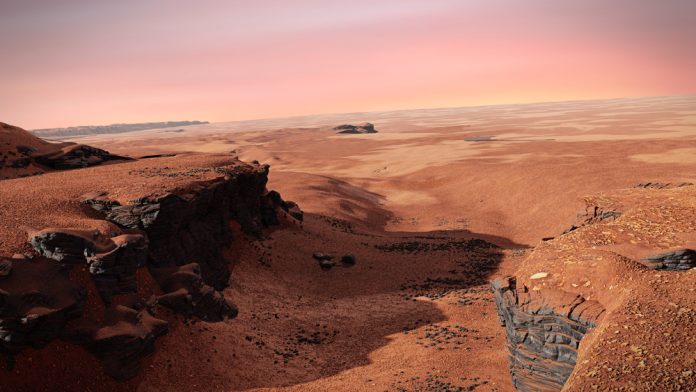Scientists have successfully identified microbe fossils in terrestrial rocks, opening up the possibility of searching for fossils on Mars.
The first life on Earth formed four billion years ago as microbes living in pools and seas – what if the same thing happened on Mars? If it did, how would we prove it?
Scientists hoping to identify fossil evidence of ancient Martian microbial life have now found a way to test their hypothesis, proving they can detect the fossils of microbes in gypsum samples that are a close analogy to sulphate rocks on Mars.
“Our findings provide a methodological framework for detecting biosignatures in Martian sulphate minerals, potentially guiding future Mars exploration missions,” said Youcef Sellam, PhD student at the Physics Institute, University of Bern, and first author of the article.
Water supply thought to have preserved fossils on Mars
Billions of years ago, the water on Mars dried up. Gypsum and other sulphates formed when pools evaporated, leaving behind minerals that precipitated out of the water – and potentially fossilising any organic life left behind.
This means that if microbes such as bacteria lived there, traces of their presence could be preserved as fossils on Mars.
“Gypsum has been widely detected on the Martian surface and is known for its exceptional fossilisation potential,” explained Sellam. “It forms rapidly, trapping microorganisms before decomposition occurs, and preserves biological structures and chemical biosignatures.”
However, to identify these microbial fossils, we first need to prove that we can identify similar fossils in places where we know such microbes existed, such as Mediterranean gypsum formations that developed during the Messinian Salinity Crisis.
Laser technology to help provide evidence
The Messinian Salinity Crisis occurred when the Mediterranean Sea was cut off from the Atlantic Ocean.
This led to rapid evaporation, causing the sea to become hypersaline and depositing thick layers of evaporites, including gypsum. These deposits provide an excellent terrestrial analogue for Martian sulphate deposits.
The scientists selected an instrument that could be used on a spaceflight: a miniature laser-powered mass spectrometer, which can analyse the chemical composition of a sample in detail as fine as a micrometre.
They sampled gypsum from Sidi Boutbal quarry, Algeria, and analysed it using the mass spectrometer and an optical microscope, guided by criteria which can help distinguish between potential microbial fossils and natural rock formations.
These include morphology, which is irregular, sinuous, and potentially hollow, as well as the presence of chemical elements necessary for life, carbonaceous material, and minerals like clay or dolomite, which can be influenced by the presence of bacteria.
Do fossils on Mars point to previous life?
The scientists identified long, twisting fossil filaments within the Algerian gypsum, which have previously been interpreted as benthic algae or cyanobacteria.
These were embedded in gypsum and surrounded by dolomite, clay minerals, and pyrite. The presence of these minerals signals the presence of organic life because prokaryotes — cells without a nucleus — supply elements which clay needs to form.
They also facilitate dolomite formation in an acidic environment like Mars by increasing the alkalinity around them and concentrating ions in their cell envelopes. For dolomite to form within gypsum without the presence of organic life, high temperatures and pressures would be needed that would have dehydrated the gypsum, which isn’t consistent with our knowledge of the Martian environment.
If mass spectrometers identify the presence of clay and dolomite in Martian gypsum in addition to other biosignatures, this could be a key signal of fossilised life, which could be reinforced by analysing other chemical minerals present and by looking for similar organically formed filaments.
Sellam concluded: “While our findings strongly support the biogenicity of the fossil filament in gypsum, distinguishing true biosignatures from abiotic mineral formations remains a challenge.
“An additional independent detection method would improve the confidence in life detection. Additionally, Mars has unique environmental conditions, which could affect biosignature preservation over geological periods.”









